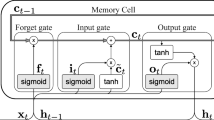Abstract
We propose a prediction model based on the minority game in which traders continuously evaluate a complete set of trading strategies with different memory lengths using the strategies’ past performance. Based on the chosen trading strategy they determine their prediction of the movement for the following time period of a single asset. We find empirically using stocks from the S&P500 that our prediction model yields a high success rate of over 51.5% and produces higher returns than a buy-and-hold strategy. Even when taking into account trading costs we find that using the predictions will generate superior investment portfolios.
Access this chapter
Tax calculation will be finalised at checkout
Purchases are for personal use only
Preview
Unable to display preview. Download preview PDF.
Similar content being viewed by others
References
Fernández-Rodríguez, F., González-Martela, C., Sosvilla-Rivero, S.: On the profitability of technical trading rules based on artificial neural networks: Evidence from the madrid stock market. Economics Letters 69, 89–94 (2000)
Allen, F., Karjalainen, R.: Using genetic algorithms to find technical trading rules. Journal of Financial Economics 51, 245–271 (1999)
Marshall, B.R., Young, M.R., Rose, L.C.: Candlestick technical trading strategies: Can they create value for investors? Journal of Banking & Finance 30, 2303–2323 (2006)
Nam, K., Washer, K.M., Chu, Q.C.: Asymmetric return dynamics and technical trading strategies. Journal of Banking & Finance 29, 391–418 (2005)
Brock, W., Lakonishok, J., LeBaron, B.: Simple technical trading rules and the stochastic properties of stock returns. Journal of Finance 47, 1731–1764 (1992)
Lo, A.W., Mamaysky, H., Wang, J.: Foundations of technical analysis: Computational algorithms, statistical inference, and empirical implementation. Journal of Finance 55, 1705–1770 (2000)
Chen, F., Gou, C., Gua, X., Gao, J.: Prediction of stock markets by the evolutionary mix-game model. Physica A 387, 3594–3604 (2008)
Challet, D., Zhang, Y.C.: Emergence of cooperation in an evolutionary game. Physica A 246, 407–418 (1997)
Challet, D., Zhang, Y.C.: On the minority game: Analytical and numerical studies. Physica A 256, 514–532 (1998)
Challet, D., Marsili, M., Zhang, Y.C.: Modeling market mechanism with minority game. Physica A 276, 284–315 (2000)
Challet, D., Marsili, M., Zhang, Y.C.: Stylized facts of financial markets and market crashes in minority games. Physica A 294, 514–524 (2001)
Jefferies, P., Hart, M., Hui, P., Johnson, N.: From market games to real-world markets. European Physical Journal B 20, 493–502 (2001)
Johnson, N.F., Lamper, D., Jefferies, P., Hart, M.L., Howison, S.: Application of multi-agent games to the prediction of financial time series. Physica A 299, 222–227 (2001)
Howison, D.L.S., Johnson, N.F.: Predictability of large future changes in a competitive evolving population. Physical Review Letters 88, 017902 (2002)
Lee, J.W., Park, J., Jangmin, O., Lee, J., Hong, E.: A multiagent approach to q-lerning for daily stock trading. IEEE Transactions on Systems, Man and Cybernetics - Part A: Systems and Humans 37, 864–877 (2007)
Krause, A.: Evaluating the performance of adapting trading strategies with different memory lengths. q-fin.PM 0901.0447v1
Leigh, W., Frohlich, C.J., Hornik, S., Purvis, R.L., Roberts, T.L.: Trading with a stock chart heuristic. IEEE Transactions on Systems, Man and Cybernetics - Part A: Systems and Humans 38, 93–104 (2008)
Author information
Authors and Affiliations
Editor information
Editors and Affiliations
Rights and permissions
Copyright information
© 2009 Springer-Verlag Berlin Heidelberg
About this paper
Cite this paper
Krause, A. (2009). Evaluating the Performance of Adapting Trading Strategies with Different Memory Lengths. In: Corchado, E., Yin, H. (eds) Intelligent Data Engineering and Automated Learning - IDEAL 2009. IDEAL 2009. Lecture Notes in Computer Science, vol 5788. Springer, Berlin, Heidelberg. https://doi.org/10.1007/978-3-642-04394-9_87
Download citation
DOI: https://doi.org/10.1007/978-3-642-04394-9_87
Publisher Name: Springer, Berlin, Heidelberg
Print ISBN: 978-3-642-04393-2
Online ISBN: 978-3-642-04394-9
eBook Packages: Computer ScienceComputer Science (R0)




